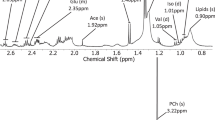Abstract
Well-characterized cell lines established from primitive neuroectodermal tumours (PNETs) were examined by proton nuclear magnetic resonance (1H-NMR) spectroscopy and chromatographic analysis of perchloric acid extracts, following amplification in cell culture. A characteristic 1H-NMR spectroscopic metabolite pattern was found for medulloblastoma cell lines, which clearly discriminates these cells from PNETs of other locations in the central nervous system (CNS), on the basis of their N-acetyl aspartate (NAA) and aspartate expression. Medulloblastoma cell lines were heterogeneous in respect of their metabolite expression, possibly owing to the heterogeneity in their differentiation along lineages of the CNS. All PNET spectra displayed similar features, including decreased NAA and creatine peaks and increased signals from choline compounds (Cho) compared with normal cerebellum. The expression of NAA by the medulloblastoma lines was in the opposite order to the extent of neuronal differentiation, which may indicate their origin from a progenitor cell with the phenotype of an oligodendrocyte-type-2 astrocyte cell.
Similar content being viewed by others

Author information
Authors and Affiliations
Rights and permissions
About this article
Cite this article
Florian, CL., Pietsch, T., Noble, M. et al. Metabolic studies of human primitive neuroectodermal tumour cells by proton nuclear magnetic resonance spectroscopy. Br J Cancer 75, 1007–1013 (1997). https://doi.org/10.1038/bjc.1997.173
Issue Date:
DOI: https://doi.org/10.1038/bjc.1997.173
- Springer Nature Limited



